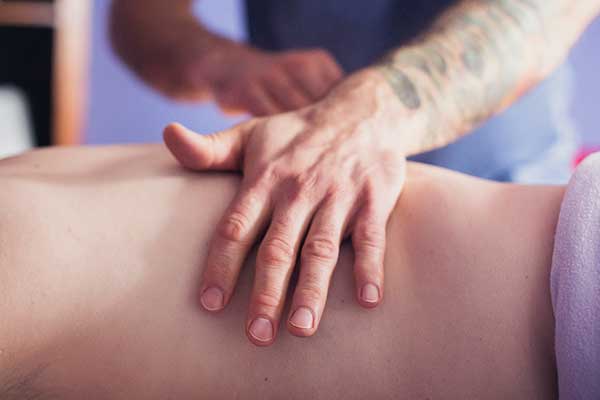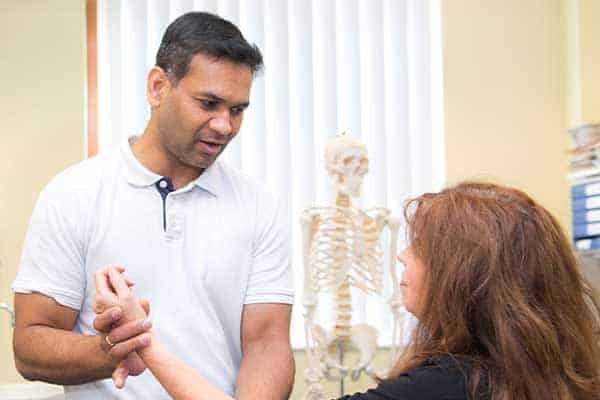Sciatica is a term for certain types of pain that feel as though they are in your leg but are actually related to the sciatic nerve in your lower back.
What causes sciatica?
The sciatic nerve runs from your lower back down to your feet. Typically this nerve becomes irritated near the top, but the symptoms are felt further down.
Sciatica can be caused when the nerve is compressed by another structure in your spine, such as a disc. It might also be caused by inflammation of the area due to an injury or another condition.
What are the symptoms of sciatica?
Sciatica can cause many different symptoms. Typically, these are felt in the buttock and back of one leg, sometimes as far as the foot, and can be very intense.
For most people, these include some or all of the following:
- A burning sensation and/or sharp pain.
- A painful cold sensation.
- Pins & needles, tingling and/or a feeling of ‘electric shocks’.
For some people, additional symptoms might include:
- Numbness and/or loss of feeling.
- Weakness in the muscles, affecting mobility.
- Pain in your lower back.
How is sciatica diagnosed?
If you develop symptoms of sciatica and have not had it before, you are advised to make an appointment with your doctor or a physiotherapist. They will be able discuss your symptoms to ensure that it is really sciatica and not a different type of back-related pain.
If you have the symptoms on both sides at the same time, or if you experience any of the symptoms of serious back pain, you should seek medical help immediately.
What are the treatment options for sciatica?
Sciatica will usually go away by itself. However, you can help to make this happen.
Although you may wish to take it easy while you establish how best to manage your pain, do not be over-cautious. You are safe to move and will not cause further damage.
If you keep moving, and control your pain, you should be able to build back into your normal daily routine.
You could try some simple stretching and mobility exercises to help maintain the health of your back and legs. Choose the most comfortable exercise for you and build up slowly through the others, avoiding anything that makes your symptoms get worse.
You could also apply gentle heat or ice to the painful areas. (Do not put ice directly next to skin as it may cause an ice burn. Wrap it in a damp tea towel.)
Paracetamol-based painkillers can help by enabling you to continue with your normal activities. Anti-inflammatory painkillers such as Ibuprofen can also be helpful in reducing pain. You could also ask your GP or pharmacist about specific nerve pain medication.
Controlling pain is also important for getting a good night’s sleep, which can be an important factor in your recovery from sciatica. You may find it helps to put a pillow between your legs when sleeping on your side, or beneath your legs when sleeping on your back.
In a minority of cases, if your symptoms persist your doctor may offer you other treatments, including injections or surgery.
What is the prognosis (outlook) for sciatica?
Depending on how severe it is, sciatica can take 4-8 weeks, or even longer, to get better.
If it has not improved after three months, you should consult a healthcare professional.
Recommended exercises (click to expand):
Cat camel
- Kneel on all fours with your hands below your shoulders and your knees below your hips. Find a neutral position for your spine and head, looking down between your hands.
- Sink your back down towards the floor, lift your head up and push your tailbone out, making a downward-curved saddle shape with your spine like a cat stretching.
- Hold this position.
- Now arch your back up in the opposite direction by tucking your head and tailbone in and pulling your belly button in towards your spine, making a camel’s hump with your spine.
- Hold this position and then repeat.
Child pose
- Start on all fours, with your shoulders above your hands and your hips above your knees.
- Drop your buttocks back onto your heels.
- Stretch your hands forwards, dropping your head between your shoulders towards the floor.
- Hold this pose to gently stretch your back and upper arms.
Prone extension
- Lie on your front with your forearms under your shoulders.
- Push your chest upwards with your forearms, raising your head to look forwards and extending the lower back.
- Keep your hips pressed into the floor and your legs straight.
- Hold this position and then relax.
Seated flexion
- Sit on an upright chair with your knees about as far apart as the width of your shoulders.
- Put your hands together and slowly bend forward at the waist to slide your arms in between your knees, down towards the floor and beneath the chair.
- You can control the pace of the forward bend by gently pressing your arms against your inner thighs.
- Reach as far as you can beneath the chair with both arms, allowing your lower back to stretch. Breathe in and out normally during this stretch.
- To bring yourself back up, put one hand on your foot for support and then place your other hand just above your knee.
- Use the hand on your knee to push yourself gently back into a seated position.

How to get referred
Find out how to get referred to Practice Plus Group MSK & Diagnostics for NHS treatment.




